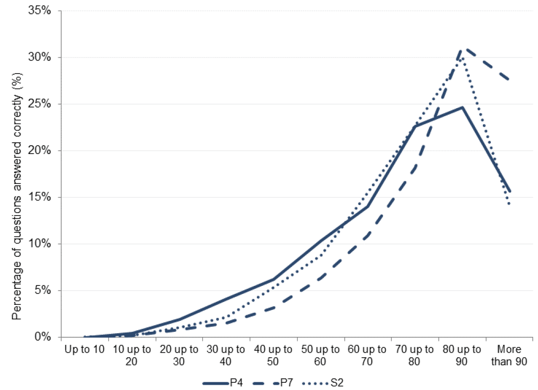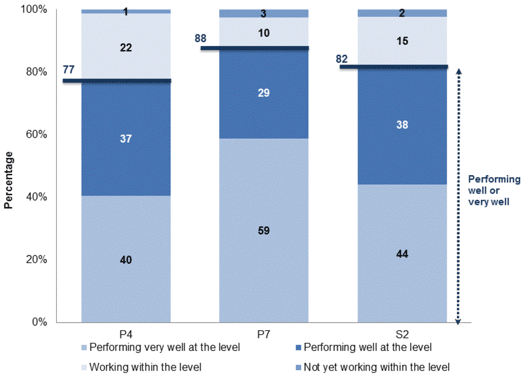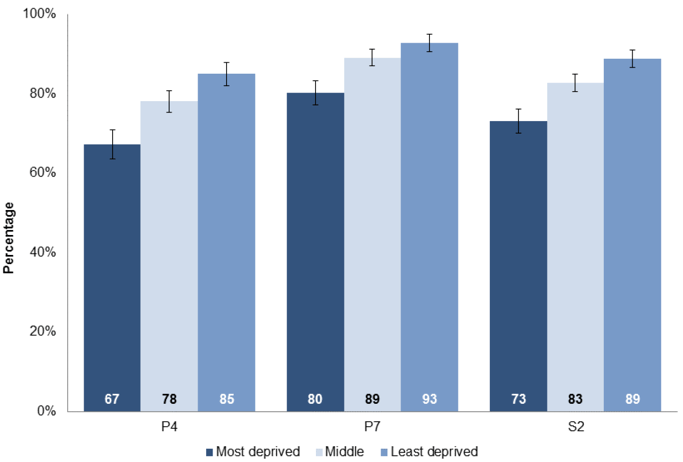Scottish Survey of Literacy and Numeracy 2016: literacy
Literacy results from the 2016 survey which covers assessment of school pupils at various stages in primary and secondary school.
Chapter 2: Reading attainment in 2016
- Reading performance was highest at P7 with 88 per cent of pupils performing well or very well, compared to 77 per cent at P4 and 82 per cent at S2.
- Girls outperformed boys at P7 and S2; there was no difference between boys' and girls' performance at P4.
- Pupils from the least deprived areas performed better in reading than other pupils, across all stages .
2.1 Assessing reading skills
All participating pupils took part in a reading assessment. This consisted of two components: a written booklet consisting of four tasks, each incorporating a source reading passage and a set of questions; and an online assessment containing four tasks: two based on webpage texts and two based on moving image texts (for example a BBC Newsround clip or a television advertisement for a children's museum).
Figure 1 provides an illustration of a pencil and paper reading task developed for the SSLN. The text is an article about the first human in space.
Figure 1: Illustration of a Third Level (S2) Pencil and Paper Reading Task 'Into Space'

Reading results are based on pupils who completed both components of the reading assessment (written booklet and online assessment). In 2016, this gave an achieved sample size of 3,184 pupils in P4, 3,287 in P7 and 3,600 in S2.
Pupils are assigned to one of four reporting categories based on the percentage of questions they answer correctly. Table 2.1 describes the categories used for each performance level in the reading assessment. The cut-off scores were set in consultation with Education Scotland, SQA and teachers, based on professional judgement and an analysis of the tasks involved in the assessment.
Table 2.1 Cut-off scores for SSLN reading reporting categories
| SSLN reading reporting category |
Percentage of items successfully completed in the SSLN |
|---|---|
| Performing very well at the level |
80 per cent or more |
| Performing well at the level |
60 per cent or more, but less than 80 per cent |
| Working within the level |
P4: more than 25 per cent, but less than 60 per cent |
| P7: more than 39 per cent, but less than 60 per cent |
|
| S2: more than 34 per cent, but less than 60 per cent |
|
| Not yet working within the level |
P4: 25 per cent or less |
| P7: 39 per cent or less |
|
| S2: 34 per cent or less |
For example, pupils correctly answering 80 per cent or more of the reading questions across all tasks are described as 'performing very well at the level'. As the assessments are designed to cover the full range of outcomes within the curriculum at a given level, such a pupil might be expected, in general, to achieve at least 80 per cent across all tasks at their level. Pupils described as 'working within the level' have achieved some of the outcomes expected for their stage, but are still working on achieving the others.
For each stage, the differing cut-off scores between 'working within the level' and 'not yet working within the level' were determined by assessing the number of marks that could potentially be obtained in the assessment using only skills acquired at the previous level or, in the case of multiple choice items, by chance.
2.2 Reading attainment
The distribution of reading scores for each of the three stages assessed can be seen in Chart 2.1. At all stages, the distribution is skewed towards high performance: 25 per cent of P4 pupils answered 80-89 per cent of reading questions correctly, this was 31 per cent at P7 and 30 per cent at S2.
Chart 2.1: Distribution of reading scores by stage

'Up to 10' included 0 and all values up to but not including 10, etc.
Chart 2.2 shows the performance of P4, P7 and S2 pupils in reading as per the four reporting categories described in Table 2.1.
Chart 2.2: Performance in reading, by stage and reporting category

Reading performance was highest for P7 pupils, with 88 per cent performing well or very well at Second Level. The majority of this comprised pupils performing very well at the level (59 per cent) compared to pupils performing well at the level (29 per cent). With respect to P4 and S2 pupils, 77 per cent and 82 per cent of pupils were performing well or very well, respectively. This included, at both P4 and S2, around two fifths of pupils were performing very well at the level.
The proportion of pupils within each stage not yet working within the level for the relevant stage was very low at one per cent at P4, three per cent at P7 and two per cent at S2.
The experimental statistics publication 'Achievement of Curriculum for Excellence (CfE) Levels 2015/16' also presents a measure of reading performance for P4 and P7 pupils. For more information see Background Note 10.9. The results cannot be compared directly to the SSLN due to the differing methodologies and reporting styles, however, we can see that a similar proportion of P4 pupils were assessed as having achieved First Level (75 per cent) by their class teacher as were seen to be performing well or very well in reading in the SSLN (77 per cent). A lower proportion of P7 pupils were assessed as having achieved Second Level (72 per cent) than were performing well or very well in reading in the SSLN (88 per cent).
Where there was a noticeable difference in trend was in the national figures for P4 and P7. The SSLN results have consistently shown that a higher proportion of P7 pupils, than P4 pupils, perform well or very well in reading at the relevant level. However, the Achievement of Curriculum for Excellence Levels results showed a slightly higher proportion of P4 pupils were assessed as having achieved the relevant level than in P7.
2.3 Attainment by gender
The proportion of girls performing well or very well in reading was higher than for boys in P7 and S2. For P7 this was a difference of five percentage points and, for S2, eight percentage points. There was no statistically significant difference in reading performance between girls and boys at P4.
Looking at the reporting categories separately, a greater proportion of girls performed very well in reading at all stages, compared to boys. The differences were four percentage points at P4, five at P7 and ten at S2. With respect to pupils performing well at the level there was no difference in performance by gender.
Chart 2.3: Proportion of pupils performing well or very well in reading, by stage and gender

A gender difference in reading attainment was also present in Scotland's latest Programme for International Student Assessment ( PISA) 2015 results. Pupils participating in PISA 2015 were 15 year olds and at a different stage of education than those assessed in the current SSLN. These results found that girls significantly outperformed boys in reading, which was consistent with the findings of previous PISA studies.
2.4 Attainment by deprivation
The difference in the proportion of pupils who performed well or very well by deprivation category is displayed in Chart 2.4. Across all stages the proportion of pupils who performed well or very well increased moving through the deprivation categories (from most, middle to least deprived). This results in a stepped pattern where performance improves as level of deprivation declines.
Chart 2.4: Proportion of pupils performing well or very well in reading, by stage and deprivation category

Performance was highest for pupils from the least deprived areas at all stages (85 per cent at P4, 93 per cent at P7 and 89 per cent at S2), compared to pupils from the most deprived areas (67 per cent at P4, 80 per cent at P7 and 73 per cent at S2).
The performance gap (the difference between the proportion of pupils from the least and most deprived areas performing well or very well) was largest for P4 at 18 percentage points, compared to 13 percentage points at P7 and 16 percentage points at S2.
Contact
Email: Marion MacRury
Phone: 0300 244 4000 – Central Enquiry Unit
The Scottish Government
St Andrew's House
Regent Road
Edinburgh
EH1 3DG
There is a problem
Thanks for your feedback